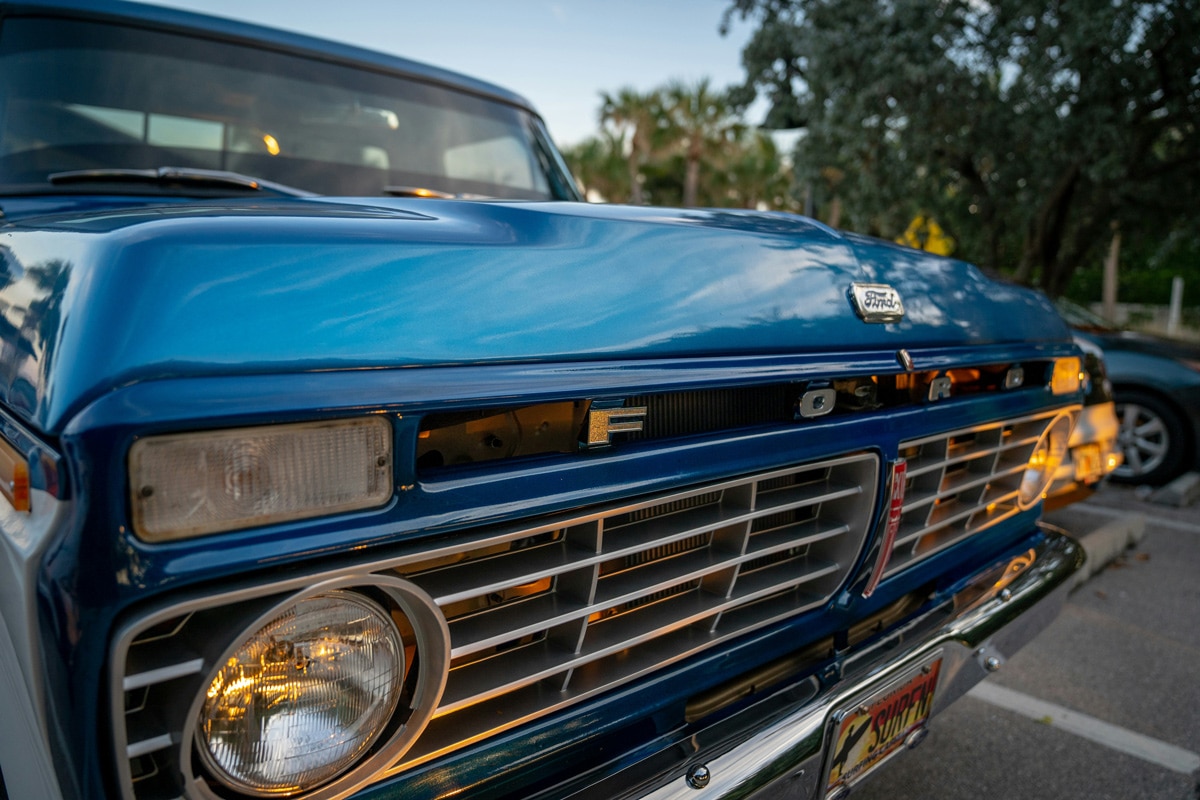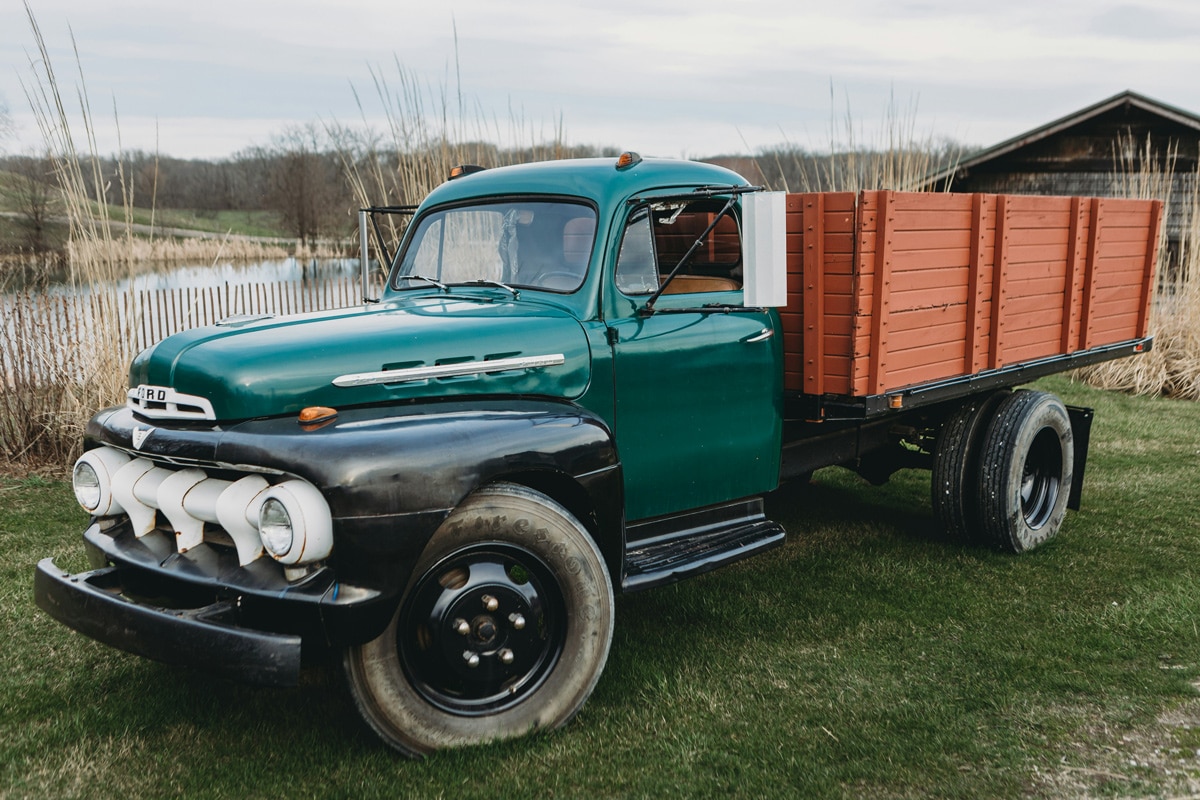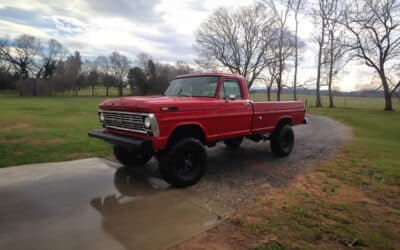We’re all familiar with Ford, a brand that has been an integral part of the auto manufacturing industry for decades. However, what consistently stands out in their lineup are their iconic vintage Ford F-Series trucks.
These classics have come a long way since the first Model TT hit the road in 1917.

Key Takeaways
- The Ford F-Series trucks hold a prestigious place in automotive history, with a lineage that dates back over a century.
- Beginning with the Model TT in 1917, Ford’s trucks have showcased innovation and practicality, influencing the industry standard.
- Vintage Ford trucks are celebrated for their durability, classic design, and the powerful emotional connection they evoke among enthusiasts.
- These vehicles not only exemplify a legacy of American craftsmanship but also represent the evolution of work vehicles to lifestyle symbols.
Jump To A Section
The Evolution of Ford F-Series Trucks
The F-Series has seen multiple evolutions throughout the decades. It all started with the early models – the TT, AA, BB, 50 and 67 – setting a solid foundation for the Bonus-Built F-Series in 1948. This paved the path for the birth of the beloved F-1 and F-100, eventually leading to the best-selling F-150.
In the 70s, the sixth generation of Ford F-Series trucks rolled out, along with the regular cab F-350. Embracing the “Styleside” bed design, it became an instant hit. The 90s saw the introduction of a fresh lineup of Ford F-Series trucks, epitomizing the blend of strength and style.
These evolutions didn’t come to a halt in the 90s. The last F-100 was produced in 1983 but production actually continued past the seventh generation and into the eighth generation. So, the F-100 spanned parts of both the seventh and eighth generations before being replaced by the F-150 in 1984. With nearly a million sold, the F-100 became America’s favorite pickup, impressing as a true workhorse.

The F-Series trucks have been segmented into generations, each marking an era of change and innovation. The first generation started with the F-1 introduced in 1948 and ran until 1952. The second generation spanned from 1953 to 1956 and introduced the iconic F-100 model.
As we progressed, the third generation covered the years 1957 to 1960 and saw the debut of the F-350. The fourth went from 1961 to 1966. Ford introduced the fifth generation between 1967 and 1972, which further solidified Ford’s reputation for durability and performance.
The sixth generation, recognized for the introduction of the F-250 SuperCab, stretched from 1973 to 1979. The seventh, which lasted from 1980 to 1986, did not mark the end of the F-100, as production continued until 1983.
Subsequent generations continue to build upon this storied legacy, with the current generation starting in 2021. Each of these eras showcases Ford’s commitment to innovation and the ever-increasing demands of the pickup truck market.
The Mystique of the Highboy
The term “Highboy” refers to a certain group of Ford F-250 4×4 pickup trucks manufactured between 1967 and 1977.
The Highboy wasn’t an official Ford designation but a nickname coined by enthusiasts, probably because of the truck’s lofty stance and the use of a divorced transfer case. Despite production ceasing years ago, the rugged features, unique design, and easy handling of Highboys continue to charm truck aficionados.
The allure of the Highboy is further emphasized by its impressive off-road capabilities, large tires, and a narrower frame that offers superior agility and ground clearance unmatched by contemporary models.
Despite its age, the durability of the Highboy is legendary; these trucks were built to withstand the toughest of conditions. It’s noteworthy that parts for the Highboy are still sought after in the restoration community, underlining the model’s enduring popularity and the dedication of its enthusiasts.
Fans of the Ford Highboy often recount stories of its raw power and ability to traverse rough terrains with ease, cementing its status as a symbol of rugged American automotive history.
Finding and Recognizing a Highboy Today
In the present day, locating a vintage Highboy for sale is akin to unearthing a hidden gem, but it is certainly possible for the determined seeker. Classic car auctions, online marketplaces, and specialty truck forums are prime hunting grounds for these vehicles. Enthusiasts often scour through listings on sites like eBay Motors, ClassicCars.com, and Hemmings, or join Facebook groups and forums dedicated to vintage Fords.
Recognizing a genuine Highboy requires a keen eye for detail. Key indicators include the aforementioned divorced transfer case, which means that the transfer case is not directly attached to the transmission.
Highboys also generally possess a factory lift thanks to the narrower frame and taller blocks between the frame and rear leaf springs, alongside the larger than standard tires. All of these elements contribute to the Highboy’s elevated stature.
Moreover, one should verify the production year, as the official Highboy models were only made between 1967 and 1977. These characteristics help distinguish the Highboy from other contemporaneous trucks and make it a compelling find for collectors and enthusiasts alike.
While acknowledging the Ford Highboy’s charm and historical significance, it’s also important to consider potential drawbacks.
Fuel efficiency might not be its strong suit, and parts availability, while surprisingly good, could come with a premium compared to more common models.
Still, for those seeking a piece of automotive history that combines raw power, legendary durability, and unique off-road prowess, the Ford Highboy remains a compelling choice, offering an experience unmatched by modern trucks.

Restoring and Customizing Classic Ford Trucks
Restoring and customizing your classic Ford truck can indeed be a rewarding process. With the right replacement parts and modifications, you can recreate and personalize your old Ford truck. And while customization is exciting, preserving the truck’s originality can lend it a unique charm.
Buying an Old Ford Truck: What to Consider
If you’re in the market for a classic Ford truck, there are several crucial factors to consider before making a purchase. This comprehensive guide will walk you through the essential aspects of purchasing a classic Ford truck.
Evaluating the Condition
When assessing the condition of a classic Ford truck, a meticulous inspection is essential. Key areas to focus on include:
- Body, Frame, and Mechanical Components: Carefully inspect these components for signs of wear, damage, or corrosion.
- Rust and Corrosion: Examine the underbody, frame, and body panels for any indications of rust, as addressing these issues early preserves the truck’s longevity and value.
- Engine, Transmission, Brakes, and Suspension: Assess these critical components for potential issues or wear that may affect the truck’s performance.
- Test Drive: Taking the truck for a test drive allows you to evaluate its performance and identify any unusual noises or handling issues.
- Interior: Check the interior for signs of wear and tear, ensuring all features and controls are in proper working order.
Furthermore, seek any available documentation, such as maintenance records or build sheets, to gain deeper insight into the truck’s history and condition and bring along a trusted mechanic if you don’t feel like your knowledge of the truck is good enough. It’s okay to not know everything.

Rust and Corrosion Concerns
Rust and corrosion are common concerns when buying an old Ford truck. While aluminum components in more recent models are less susceptible to corrosion, careful examination of the truck for any signs of rust, especially in critical areas, is crucial.
Addressing rust and corrosion issues early can significantly contribute to preserving the value and integrity of your classic Ford truck.
Engine Options and Performance
Classic Ford trucks boast a diverse range of engine options, each with its own impact on performance and value. Consider the following engine options:
- Inline-6 Engines: Known for reliability and fuel efficiency.
- V8 Engines: Offer greater power and torque, enhancing the truck’s performance.
- Flathead Engine: A classic option highly sought after by collectors.
It’s important to thoroughly research the available engine options and consider the desired performance and value for your truck.
Pricing and Market Trends
Understanding the current market trends for classic Ford trucks empowers you to make an informed purchase.
The vintage Ford truck market has experienced a steady increase in recent years, with prices ranging from $7,000 to $32,000.
Stay informed about market trends and pricing to ensure a wise investment when purchasing a classic Ford truck.
By carefully considering these factors, you can confidently navigate the process of purchasing a classic Ford truck and find the perfect vehicle that aligns with your needs and expectations.
Aftermarket Engine Options
For those seeking to enhance performance beyond the classic stock engines, there’s a thriving aftermarket offering exciting options like the Coyote, the Godzilla, and the Predator engines.
These modern powerhouses provide the muscle for restoration enthusiasts and custom builders to transform their classic Ford truck into a contemporary performer.
- The Coyote Engine: Ford’s Coyote V8, first introduced in the 2011 Mustang GT, delivers a blend of high-revving horsepower and modern engineering efficiency. It’s an ideal swap for those looking to upgrade to modern V8 standards while keeping the Ford lineage intact.
- The Godzilla Engine: This massive 7.3-liter V8, nicknamed Godzilla for its daunting size and power, is designed primarily for heavy-duty applications. However, its potential for immense torque has attracted the attention of performance enthusiasts looking to make a bold statement in their classic Ford builds.
- The Predator Engine: Originating from the Shelby Mustang GT500, the Predator is a supercharged 5.2-liter behemoth that offers unmatched power for those wishing to top the performance charts. Aimed at the most ambitious of custom projects, it epitomizes the advancements in engine technology, giving a new life to vintage frames.
Each of these engines comes with its set of considerations regarding the installation, including engine mounting, exhaust, cooling, and transmission compatibility.
Opting for one of these powertrains can turn a classic workhorse into a road-prowling stallion, blending nostalgia with unprecedented speed and strength.

Maintaining and Caring for Your Classic Ford Truck
The responsibility of maintaining and caring for your vintage vehicle is crucial to ensure its longevity and value.
Regular Maintenance
To keep your classic Ford truck in optimal condition, regular maintenance is paramount. A basic maintenance schedule should include:
- Washing and Waxing: Regularly washing and waxing the truck helps protect its paint and body from corrosion and maintains its timeless appeal.
- Oil Changes: Regular oil changes are vital for the engine’s health and overall performance of the truck.
- Air Filters: Replacing air filters ensures that the engine receives clean air, optimizing fuel efficiency and performance.
- Brake Maintenance: Regularly checking and adjusting brakes is crucial for safety and smooth operation of the vehicle.
- Tire Rotation: Rotating tires at regular intervals promotes even tread wear, extending their lifespan, and enhancing overall performance.
- Annual Safety Inspection: For vehicles registered as ‘Classic’, an annual safety inspection is essential to ensure compliance with safety standards.
By adhering to a diligent maintenance schedule, you can prevent potential issues and maintain your classic Ford truck in top-notch condition.
Storage Considerations
Proper storage is paramount for protecting your classic Ford truck from the elements and preserving its value. When storing your truck, consider the following factors:
- Enclosed Space: Ideally, store the truck in an enclosed space such as a garage or carport to shield it from the elements.
- Regular Usage: It’s important to start and drive the truck regularly to keep the engine and other components in optimal condition.
Taking the time to properly store and care for your classic Ford truck will significantly contribute to its longevity and maintain its value for years to come.
Insurance and Registration
Ensuring that your classic Ford truck is properly insured and registered is a critical aspect of responsible ownership. Here are some considerations:
- Insurance Requirements: Insurance providers generally require classic trucks to have a minimum value and be in good working order. Specific requirements may vary, so it’s important to consult with your insurance provider.
- Registration: Registration requirements for classic trucks may vary by state, so it’s essential to contact your local Department of Motor Vehicles for detailed information on registration procedures.
Join the Ford Truck Community
Owning a Ford truck isn’t just about driving; it’s about becoming a part of a community. Online forums, social media groups, clubs, organizations, events, and showcases are great platforms to connect with other owners and enthusiasts.
You can share experiences, learn from journeys of restoration and customization, and maybe even show off your own classic Ford truck.
In summary, owning a classic Ford F-Series truck is all about enjoying a slice of automotive history, a testament to Ford’s enduring commitment to excellence, innovation, and beauty. Whether you’re interested in the early models, Highboys, or modern F-150s, there’s a timeless classic waiting for you to explore.
Preserving a Legacy
As with any classic vehicle, owning vintage Ford F-Series trucks also means being responsible for preserving its legacy.
This includes proper maintenance, using authentic parts, and treating the truck with care and respect. By doing so, you are not only keeping a piece of history alive but also contributing to the continued admiration and appreciation for these timeless classics.
Continued Innovation
Despite their iconic status, Ford F-Series trucks continue to evolve and innovate. From new technologies like advanced towing capabilities and improved fuel efficiency to updated designs and features, the F-Series is constantly adapting to meet the needs and desires of truck enthusiasts. This ensures that these timeless classics not only hold a special place in history but also remain relevant in today’s ever-changing automotive landscape.
Final Thoughts
From their early beginnings to their continued success and evolution, the Ford F-Series trucks have secured a place in automotive history as timeless classics.
With their good looks, ability to still be used daily, and the chance to become part of such a dedicated community, it’s no wonder that these trucks continue to capture the hearts of many.
Whether you’re a long-time fan or just discovering the magic of Ford trucks, one thing is for sure – they will always hold a special place in our hearts and on the roads.
Experience history on wheels with your very own Ford F-Series truck. Become a part of the legacy and join the community today!
Frequently Asked Questions (FAQs)
What is the best way to find parts for my classic Ford truck?
You can find parts for your classic Ford truck through specialty auto parts stores, online forums, social media groups, and classic car parts auctions or swap meets. It’s often helpful to network within the Ford truck community for recommendations on reliable parts suppliers.
Is it more beneficial to restore a Ford truck to original specifications or to modify it?
This depends on your personal preference and goals. Restoring a truck to its original specifications often retains its historical value and may be preferred by classic car collectors. Modifying it can provide modern performance improvements and is typically favored by those who wish to use their truck as a daily driver.
How can I accurately determine the value of my classic Ford truck?
The value of a classic Ford truck can be determined by considering its model, year, condition, originality, and market demand. Consulting with appraisers, attending car shows, and researching auction results can provide valuable information regarding your truck’s worth.
Are there specific insurance companies that specialize in classic trucks?
Yes, there are several insurance companies that specialize in classic vehicles. They typically offer tailored policies that reflect the unique considerations of owning a classic truck, such as agreed value coverage and usage restrictions. It’s essential to shop around and find an insurer that understands the needs of classic truck enthusiasts.
What are some ways to get involved in the Ford truck community?
You can get involved by attending truck meets, join classic Ford truck clubs, participate in online forums, and follow social media accounts dedicated to Ford trucks. These are excellent ways to meet other enthusiasts, share your passion, and learn more about your vehicle.
How often should I drive my classic Ford truck if it’s primarily stored?
It’s advisable to drive your classic Ford truck at least once a month. This helps to maintain the mechanical systems, circulate fluids, and prevent issues such as flat spots on tires and seal degradation. Regular driving also ensures that any potential problems are identified and addressed early on.
What factors contribute to the cost of restoring a classic Ford truck?
The cost of restoring a classic Ford truck can vary widely, depending on the truck’s initial condition, the extent of restoration needed, availability of replacement parts, and labor costs. Factors such as the desire to use original or aftermarket parts, the specific model and age of the truck, and whether the restoration work is done professionally or as a DIY project all contribute to the overall cost.
Are there common issues to watch out for with specific models of classic Ford trucks?
Yes, certain models of classic Ford trucks may have well-known issues that enthusiasts and restorers should be aware of. For example, some early F-1 models might be prone to rust, particularly in the cab corners and door bottoms. The twin I-beam suspension in some 1960s models can lead to uneven tire wear if not regularly maintained. It’s always a good idea to research your specific model year and consult with fellow enthusiasts and professionals to understand any common issues that may arise.



